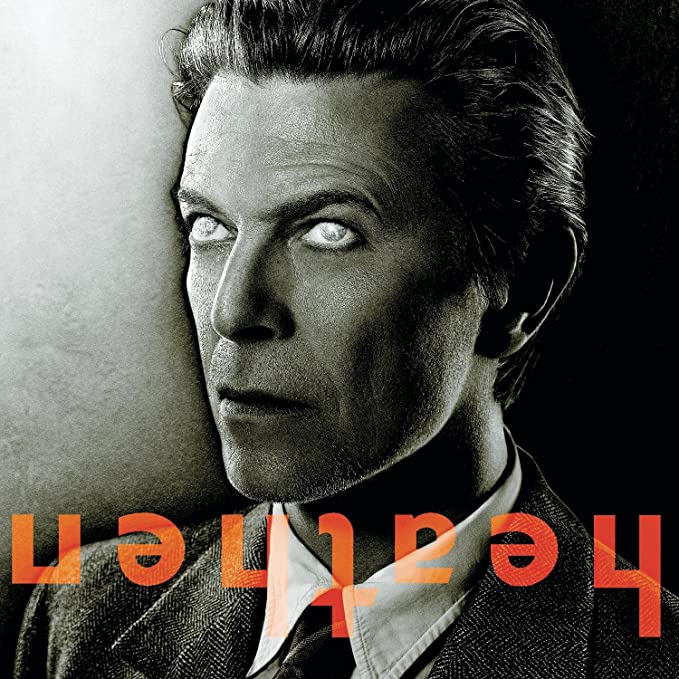
The 23 years between 1. Outside and Blackstar marked a remarkable creative resurgence for David Bowie. Singles are banned from this alternative Top 20 list, but as Will Salmon discovers, there’s a plentiful crop of classics to pick from the albums, b-sides and rarities…
20 We Shall Go To Town, Thursday’s Child (1999)
A fascinating glimpse into a world where Hours was a much more interesting album than the one we actually got… This b-side from the Thursday’s Child single is a mysterious outlier, a haunting and defiantly weird song that wouldn’t sound out of place on 1. Outside. Cutting through the gloom and Bowie’s phased vocal is a guitar riff that has the unmistakable hint of James Bond about it. Gorgeous and strange, you can see why Reeves Gabrels was so miffed when Bowie chopped it from the final album.
19 Looking For Satellites, Earthling (1997)
Earthling makes a great racket, but this meditative album track slows the pace, its hypnotic mantra rolling along until a distorted guitar solo tears things up. Bowie said of the song, “It’s kind of a poignant feeling, standing alone on a beach at night, looking for a satellite… what you’re really looking for is an answer.” A strange and lovely interlude between the album’s frenetic beatscapes that also nods to pre-Millennial interest in UFOs and alien life.
18 Pablo Picasso, Reality (2003)
Yes, it’s a cover, but Bowie’s take on The Modern Lovers’ song is a blistering rocker that shows that the old dog still could still bite and snarl when he wanted to. Bowie’s version adds some cheeky Spanish guitar (a nod, perhaps, to Picasso’s country of origin), synth and additional lyrics. Visconti’s production gives the song a fresh and appropriately modern coat of paint.
17 Looking For Water, Reality (2003)
A stripped-back rocker that continues the confident thrust of Reality, but what really makes Looking For Water stand out is its intensely bleak lyric. If Heathen felt tinged with the darkness of living in a post 9/11 America, this spells it out clearly. “I lost God in a New York minute/don’t know about you but my heart’s not in it.” For once, David Bowie, master of composure sounds authentically shaken up.
16 Dirty Boys, The Next Day (2013)
A scronking slice of rock ‘n’ blues that resembles Bowie taking on Tom Waits. Steve Elson’s baritone sax is the star of the show, but praise should also go to Tony Levin’s lurking bass. The song’s English references (Finchley Fair, cricket bats) are juxtaposed with the music’s US flavour; “stripper music from the 1950s,” as Visconti put it.
15 No Plan, No Plan (2017)
A Blackstar outtake that could have happily sat on its parent album. An elegiac rumination on living in the moment, originally written for the Lazarus musical. Bowie’s vocal (recorded on 10 January 2015, precisely one year to the day he would pass away) is frail but powerful, lending the song a melancholy but ultimately triumphant feel. In the light of its release after Bowie’s passing, the song can’t help but evoke Bowie sending a final message to us from the afterlife.
14 Sunday, Heathen (2002)
The opening track on Heathen is an atmospheric creep through some eerily desolate imagery. “Look for the cars and signs of life” may evoke 9/11, but the song was, in fact, written well before that fateful day. Whatever it’s about, Bowie stretches the tension out, building and building, only letting it out in the final few minutes. A gorgeous start to the album.
Read more: David Bowie in the 90s
Read more: Making David Bowie’s Let’s Dance
13 Shadow Man, Slow Burn/Everyone Says Hi (2002)
The earliest known version of this track dates back to at least the early 70s, but it’s likely that Bowie was working on it even before then. He dug the song out in 2000, recording a version for Toy. When that album was aborted, the track (in a subtly different form) was popped on the B-side of both the Slow Burn and Everyone Says Hi singles. It’s a lovely song, with Bowie crooning over an ethereal arrangement of strings and piano. Bowie fills it with such warmth and sincerity that it’s become a firm fan favourite.
12 I’m Deranged, 1. Outside (1995)
Made famous by its inclusion on David Lynch’s brutal classic, Lost Highway, I’m Deranged is one of 1. Outside’s most haunting tracks. Bowie’s operatic vocal rides a wave of disturbing imagery (the Verbasiser is once more in full effect here on lyrics like “Cruise me blond, Cruise me babe, A blond belief beyond beyond beyond”) while an eerie synth wash is contrasted with a frantic electronic beat that prefigures the electronica of Earthling, before finally giving way to Mike Garson doing his best ‘manic’ piano.
11 Thru’ These Architects Eyes, 1. Outside (1995)
As it comes to an end, light cracks through the mordant gloom of 1. Outside. Architects Eyes is both a release and a reward. A soaring ode to the “majesty of a city landscape” (the Johnson and Rogers name-checked on the song are architects Phillip Johnson and Richard Rogers), it also grew out of Bowie’s growing obsession with modern art, at its height in this period. Mike Garson gets a terrific descending solo in the final moments, but for once it feels joyous, rather than menacing.
10 You Feel So Lonely You Could Die, The Next Day (2013)
A showstopping torch song with a sting in the tail. Bowie throws everything at this, delivering one of his most impassioned – even melodramatic in places – vocals on the album, backed up with oohs and aahs from Gail Ann Dorsey. But while it sounds heartfelt, the sentiment here is bitter; the song’s character is sugar-coating his malice. “I hope you feel so lonely you could die,” Bowie sings after promising whoever he’s singing to that “Death alone shall love you”. Then, just as it fades out, a familiar drum beat, appears – a direct lift from Five Years that links the surprise return of The Next Day back to the best known LP in his back catalogue. A remarkable song.
9 A Small Plot Of Land, 1. Outside (1995)
A delirious, tumbling piece that prefigures the percussive jazz sound Bowie would later explore on Blackstar. Lyrically, the song is a collage of disturbing imagery (created using the same cut-up techniques he employed with Eno in the 70s, albeit with the help of the new Verbasiser technology) that may not mean too much, but is darkly evocative all the same. Not for the last time on Outside, Mike Garson steals the show here, his discordant piano lending a diabolic touch to a song that lurks in the subterranean darkness, while Sterling Campbell’s terrific drumming keeps it locked into a taut groove. Incredible and deeply eerie.
8 I Have Not Been To Oxford Town, 1. Outside (1995)
An unusual diversion into funk on the otherwise experimental Outside. Oxford Town (working title: Toll The Bell) was crafted by Brian Eno, Carlos Alomar and Joey Barron in the studio, with Bowie absent. His contribution can’t be underestimated, however – according to Eno’s diary of the period, on hearing it, Bowie was delighted. He immediately wrote the lyric, asked for five tracks and then sung the different parts, complete with “long spaces, little, incomplete lines… he unfolded the whole thing in reverse, keeping us in suspense for the main song”. A proper earworm that stands out on an occasionally obtuse album, it might have been a hit had it been given the single treatment.
Read more: Top 40 synth-pop songs
Read more: The Story Of The New Romantics
7 Heat, The Next Day (2013)
The Next Day bows out on this ominously brooding track that never quite gives you the release it feels like it’s building to. One of the first songs created during the album sessions, Gail Ann Dorsey’s bass and Visconti’s production create – or rather summon a dark ambience. Musically unlike anything else on the album, it continues the record’s lyrical bleakness while also nodding forward to the more sonically adventurous terrain Bowie would go onto explore on Blackstar.
6 The Motel, 1. Outside (1995)
The centrepiece track on 1. Outside is a haunted ballad dressed up in gothic clothing. Sprawling for nearly seven minutes (and owing an undoubted debt to Scott Walker’s astonishing, career-redefining single, The Electrician) its gradually building ambience is anchored around Garson’s piano. It’s a song that’s teetering on the edge of dour until – almost bang on the five minute mark – guitar erupts and Bowie’s defeated vocal takes on an urgent tone, releasing waves of pent up emotion.
5 Girl Loves Me, Blackstar (2016)
After the title track, the most sonically adventurous song on Bowie’s grand finale. Lyrically hewn from polari (a type of slang often used in gay subculture up until the 1960s) and Nadsat (the fictional language of Anthony Burgess’s A Clockwork Orange), it’s coded lyric is paired with a tight, deliberately repetitious groove from drummer Mark Guiliana. While the lyric is initially impenetrable, the repeated cry of “Where the fuck did Monday go?” has a sense of bleak desperation to it (and earned the album an incongruous-for-Bowie Parental Advisory sticker). An atypical track on an extremely atypical album, it proves that Bowie had the imagination to keep surprising us right up until the end.
4 Conversation Piece, Heathen Deluxe Edition (2002)
A rare entry into the Realist Bowie canon, this song is a gorgeous snapshot of urban life from the point-of-view of a lonely academic who lives “above the grocer’s store, owned by an Austrian”. Originally written in 1969, but cut from Space Oddity, Bowie revived it for his planned Toy album in 2000. When that record was canned, the track eventually made it onto the Deluxe Edition of Heathen. It’s a mark of how understated and lovely it is that, despite this comparatively unknown status, it’s become one of his best loved late period songs.
3 Slip Away, Heathen (2002)
An early standout on Heathen, Slip Away looks back to Bowie’s past, both in terms of its lyrical reference to obscure late 70s puppet TV series, The Uncle Floyd Show, and in its knowing reprise of the Stylophone, the toy instrument first deployed (in a Bowie context) on his breakout hit, Space Oddity. A gorgeous ballad that builds and builds before opening up into a majestic chorus, when we say that this feels like a lost Hunky Dory track seen through a post-Low lens, it’s meant as a very high compliment indeed. Credit should also go to Tony Visconti, whose sumptuous production on the track gives it a truly epic thrust.
2 Dollar Days, Blackstar (2016)
After the fierce experimentation of its first five tracks, Blackstar bows out with two straightforward – at least for David Bowie! – songs that get to the heart of the matter. Dollar Days was crafted in the studio, the only track on the album not to have a demo. While it’s known that Blackstar wasn’t consciously recorded as a final album, mortality is undeniably hovering around the edge of the song, even as its narrator insists “It’s nothing to me”. Shot through with a real sense of longing and blessed with a stunning sax solo, it’s an incredibly powerful piece of work.
1 Bring Me The Disco King, Reality (2003)
An outlier on the otherwise rock-heavy Reality, Disco King is a song with a long history, stretching back at least until the 90s and Black Tie White Noise. First a – in Bowie’s own words – “cheesy” disco number, then a sparse piano and string-led piece, it’s reconfigured on Reality into a sprawling, near eight-minute cut of smokey late night jazz, far smoother than the jarring textures of his later experiments in the genre. As the final track on Reality, for many years this was the “last David Bowie song” and the lyric certainly hints at the creep of mortality. The (welcome!) surprise appearance of The Next Day may have robbed it of that status, but it remains one of the greatest songs of his long career.
The alternative David Bowie Top 20 – 1975-’80
Read more: The alternative David Bowie Top 2O – 1981–’93
Classic Pop may earn commission from the links on this page, but we only feature products we think you will enjoy.


